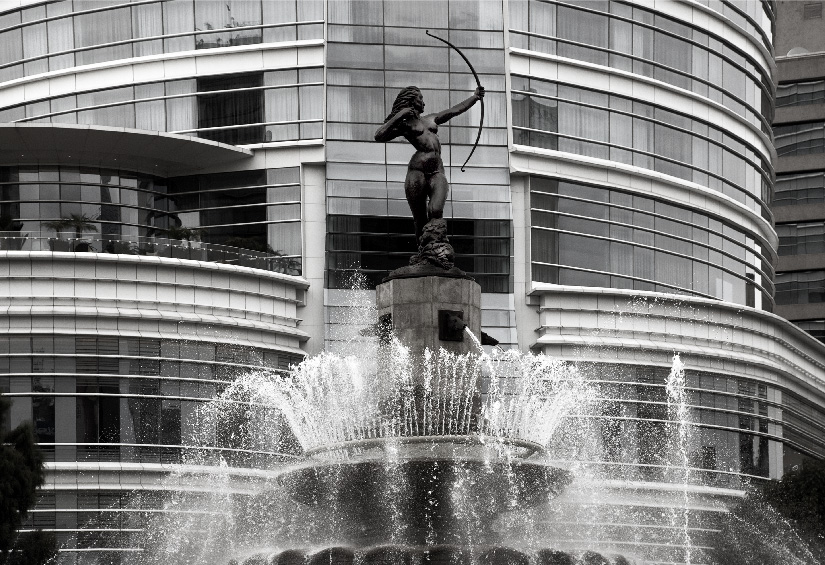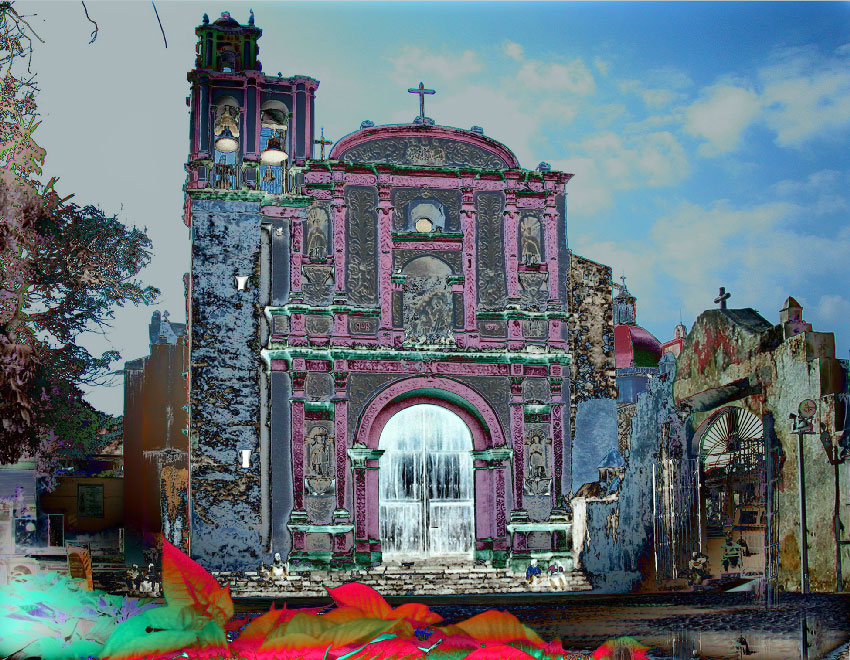The Magic of the Cities.
Zen promotes the rediscovery of the obvious, which is so often lost in its familiarity and simplicity. It sees the miraculous in the common and magic in our everyday surroundings. When we are not rushed, and our minds are unclouded by conceptualizations, a veil will sometimes drop, introducing the viewer to a world unseen since childhood. ~ John Greer
Monday, February 14, 2011
Venezia II
Sunday, February 13, 2011
Venezia I
 |
| Santa Maria della Salute |
 |
| Punta della Dogana Mapping The Studio - Palazzo Grassi |
 |
| Google Earth |
 |
The surface of Venice is constantly metamorphosing [and] painting Venice is almost like being a restorer, peeling off the layers to find the picture after picture underneath.” ~Arbit Blatas |
Saturday, February 12, 2011
Venus
Friday, February 11, 2011
Bronze and Flesh
 |
| Installation of sculptures in main square of Cuernavaca (not finished yet) |
 |
| Street Vendor in rural Mexico |
Mexico's rampant poverty, lagged social development and general public welfare is strongly tied to its politics. Historically, the political system of Mexico has not favored the general population, mainly because it focused to become and be a single-party system of government, largely dubbed "institutionalized" where those in charge had a one-voice, unquestionable plan of action mainly focused to favor the few elite while ignoring the welfare of the rest of population. From the 1800s to the end of the 20th century, as presidential administration came and went, the forms of government has been described as authoritarian, semi-democracy, centralized government, untouchable presidencies, mass-controlling, corporatist and elite-controlled. As each administration took turn, some changes have occurred, sometimes as to contribute to the welfare of the least fortunates but history has clearly shown that poverty has remained constant at any given time in the history of Mexico. Overall, the political framework behind the economic and social structure of the country continues to be the greatest contributor to inequality. The political economy of the country has been inadequate and unfair for many decades.
Corruption is rampant in Mexico. Mexico's government has been historically corrupt at all hierarchical levels: federal, state, and local. Mexico ranks high-to-very high among most corrupted countries in the world. The cost of corruption in Mexico is equal to 9 percent of the country's GDP. Business companies admit to spend as much as 10 percent of their revenue in bureaucratic bribes. 39 percent is spent on bribing high-ranking policy makers and 61 percent on lower-ranking bureaucratic-administrative office holders. At least 30 percent of all public spending ends up in the pockets of the corrupt. With these rankings, it is clear that the unethical practices by government officials directly affect the population, their development and the state of poverty in which they remain. [Wiki]
Thursday, February 10, 2011
Kaleidoscake
Wednesday, February 9, 2011
Fisherman's Village
Tuesday, February 8, 2011
Under The Volcano
Saturday, February 5, 2011
Saturday Blues
Friday, February 4, 2011
Rest
 |
| Taking a break in Tepoztlan Sunday street market. |
 |
| Irina from Irina's Paintings and Moscow Daily Photo honored me with this great sketch of the above photo. Thank you very much! |
Thursday, February 3, 2011
Battery Park
Cymbaline
The path you tread is narrow
And the drop is sheer and very high
The ravens all are watching
From a vantage point nearby
Apprehension creeping
Like a tube-train up your spine
Will the tightrope reach the end
Will the final couplet rhyme
And it's high time
Cymbaline
It's high time
Cymbaline
Please wake me
A butterfly with broken wings
Is falling by your side
The ravens all are closing in
And there's nowhere you can hide
Your manager and agent
Are both busy on the phone
Selling coloured photographs
To magazines back home
And it's high time
Cymbaline
It's high time
Cymbaline
Please wake me
The lines converging where you stand
They must have moved the picture plane
The leaves are heavy around your feet
You feel the thunder of the train
And suddenly it strikes you
That they're moving into range
Doctor Strange is always changing size
And it's high time
Cymbaline
It's high time
Cymbaline
Please wake me
And it's high time
Cymbaline
It's high time
Cymbaline
Please wake me
~ Pink Floyd
Wednesday, February 2, 2011
Versions
 |
| Diana Fountain |
 |
| Waves |
 |
| Blue |
 |
| Trumer Pils. Vienna 2010 |
 |
| Abstract Truth |
Tuesday, February 1, 2011
February 2011 Theme Day: Fountains
 |
| Fray Bartolome de las Casas St. Cuernavaca |
 |
| Cuernavaca Cathedral Atrium |
Monday, January 31, 2011
Devoured
Friday, January 28, 2011
Umbrellas
Wednesday, January 26, 2011
Could Be Everywhere
Tuesday, January 25, 2011
David
Monday, January 24, 2011
Time
 |
Man on Ice (take at The Ice Skating Rink at Rockefeller Center. NYC) |
 |
Cro-Magnon (take at American Museum of Natural History. NYC) The Cro-Magnon were the first early modern humans (early Homo sapiens sapiens) of the European Upper Paleolithic in Europe. The earliest known remains of Cro-Magnon-like humans are radiometrically dated to 35,000 years before present. Etymology The name derives from the Abri de Crô-Magnon (French: rock shelter of Crô-Magnon) near the commune of Les Eyzies-de-Tayac-Sireuil in southwest France, where the first specimen was found. Being the oldest known modern humans (Homo sapiens) in Europe, the Cro-Magnon were from the outset linked to the well-known Lascaux cave paintings and the Aurignacian culture that flourished in southern France and Germany. As additional remains of early modern humans were discovered in archaeological sites from Western Europe and elsewhere, and dating techniques improved in the early 20th century, new finds were added to the taxonomic classification. Absolute Astronomy The Future of Human Evolution Our Future As we look toward the future, experts debate whether we might alter the course of human evolution. What does the future hold for humanity? It is beyond the reach of science to peer ahead hundreds, thousands or millions of years with any certainty. But it is clear that our survival, like that of any species, depends on the potential of our species to adapt to a changing environment. While humans have adapted to such changes many times in the past, the future presents new challenges. Humans are no longer passive agents in the evolutionary process. The environment will always shape us, but we in turn are now shaping the environment. Today our world is changing rapidly, largely because of human activity. The atmosphere is getting hotter, wild habitats are disappearing and countless species are going extinct. These changes pose threats to the natural resources we depend on—and could ultimately threaten our quality of life and even survival. At the same time, humans have an extraordinary capacity to improve the future. Given the wondrous achievements in human history, from the wheel to computers and spacecraft, our potential for advances in art, science and technology is incalculable. By taking an active role in transforming our world and ourselves, we will affect our destiny, for better or worse. How might we use—or abuse—our capacity? Will we really change the course of human evolution? ARE HUMANS STILL EVOLVING? In this era of global travel and interconnected societies, we no longer have small, isolated populations evolving in different directions, as was the case earlier in human evolution, helping to drive the emergence of new species. The human genome continues to change in minor ways, but under present conditions a new human species more than likely will not emerge. COULD A NEW HUMAN SPECIES EVOLVE? Human populations might once again become small and isolated and a new species might then emerge if humans experienced environmental collapse, war, pandemic disease or geological catastrophe on a massive, global scale. Certain experts think another scenario is also possible. By directly manipulating the human genome, some humans could be altered so significantly that, if reproductively isolated from other humans, they might become a separate species. Critics disagree, claiming that there will be enormous technical, political or moral barriers to making significant changes to the human genome. More about: Dance of The Tiger by Björn Kurtén The Inheritor by William Golding |
 |
Friendship (Photomanipulation) |
Thursday, January 20, 2011
Workers
Wednesday, January 19, 2011
Third Order
 |
The cathedral, began life as a Franciscan friary, founded by Hernán Cortés in 1529. Work started on the fortress-like complex in 1533. The side portal of the church has a fine colonial-Plateresque façade with, above the gable, the symbols of a crown, cross, skull and bones framed by an alfiz. During restoration of the cathedral interior in the 1950s, some early murals were uncovered depicting the departure of 24 Mexican Franciscan friars, embarking at the start of their missionary journey to Japan, and their subsequent martyrdom on the cross in 1597. Among them was Mexico's only saint, San Felipe de Jesús. The Chapel of the Third Order, at the rear of the monastery building, has a very typical Mexican Baroque façade, embellished with a small figure representing Hernán Cortés. Like the chapel's lovely carved wooden altar (1735), the façade shows strong Indian influence. Adjoining the cathedral stands the spacious Open Chapel, its vaulting supported on three arches. Two buttresses reinforce the central columns. Remains of murals showing the lineage of the Franciscan order can be seen in the cloister. Every Sunday a folk mass is celebrated in the cathedral to the accompaniment of mariachi music. If you wish you can see another views of this magnificent building here and here. |
music+image
Thanks for visiting, please be sure that I read each and every one of your kind comments, I appreciate them all and I'll respond when the inexorable time permits.
Thanks for visiting, please be sure that I read each and every one of your kind comments, I appreciate them all and I'll respond when the inexorable time permits.
Tuesday, January 18, 2011
Bargains Month
 |
Bazaar. Cuernavaca, Mx. |
Subscribe to:
Posts (Atom)































